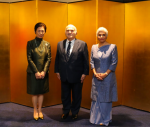You are here
The return of the madman theory
Sep 25,2017 - Last updated at Sep 25,2017
In the 1970s, US president Richard Nixon instructed secretary of state Henry Kissinger to convince the leaders of hostile communist countries that he could be erratic and volatile, particularly when under pressure.
Kissinger, a shrewd practitioner of Realpolitik, saw the potential in this approach, which he readily implemented.
With that, the “madman theory” of diplomacy was born.
Nixon was far from mad, though his heavy drinking at the height of the Watergate scandal prompted Kissinger and secretary of defence James Schlesinger to establish a way to monitor his control of the nuclear codes.
Nixon’s goal in trumpeting his supposed erratic nature was to stoke fear among his foreign adversaries that making him angry or stressed could result in an irrational — even nuclear — response, thereby impelling them to check their own behaviour.
Today, with Donald Trump leading the United States, the madman doctrine is back with a vengeance. But this time around, it is far less clear that it is just an act and that Trump would not really decide, in a fit of rage or frustration, to attack, or even nuke, his opponents.
Exhibit A in a hearing on Trump’s sanity would have to be his recent address to the United Nations General Assembly, which resembled the lunatic ramblings of Aerys Targaryen, the “mad king” in the television show “Game of Thrones”.
Putting his own spin on Targaryen’s infamous line “burn them all”, Trump threatened that the US would “totally destroy” North Korea if it continues to develop its nuclear programme.
In the same speech, Trump also savaged the 2015 nuclear agreement with Iran. As he spoke, his chief of staff, retired US Marine Corps General John Kelly, who was appointed in July to bring order and a degree of stability to Trump’s White House sanatorium, could be seen with his head in his hands, as if in shock or despair.
Many Americans have perhaps grown desensitised to Trump’s off-the-wall tirades, having endured months of his late-night Twitter assaults on the press, his opponents and fellow Republicans, even his own Cabinet members.
The famously thin-skinned Trump has shown that, when provoked or insulted, he can be counted on to retaliate. But unlike many of Trump’s previous unhinged ramblings, the UN speech was read from a teleprompter, which means that it was vetted ahead of time.
Those who thought that the “grownups” in Trump’s administration — Kelly, Secretary of Defence Jim Mattis and National Security Adviser H.R. McMaster — would keep US security strategy within the bounds of reason might need to think again.
Perhaps the maddest part of all is Trump’s apparent calculation that North Korea’s boy-king Kim Jong-un might cower in the face of his threats.
After president Ronald Reagan called the Soviet Union an “evil empire” in 1983, he was advised not to repeat it, in the interest of improving the bilateral relationship.
Recognising the importance of such an improvement for mitigating the nuclear threat, Reagan followed his advisers’ counsel. The same cannot be said of Trump, who surely has been warned of the dangers of hurling insults like “Rocket Man” at the brutal and inexperienced Kim.
When Nixon adopted his own “mad” persona, he was in some ways drawing on the example of Nikita Khrushchev, my grandfather and Nixon’s adversary during his tenure as US vice president.
In the so-called “kitchen debate” of 1959 — one of the Cold War’s weirdest moments — Nixon sparred with Khrushchev in Moscow over the superiority of capitalism over socialism.
A year later, at the UN General Assembly in New York, Khrushchev made quite the appearance.
Cuba’s new revolutionary leader Fidel Castro was, as was his wont, flamboyantly issuing extravagant threats. Not to be outdone, “Hurricane Nikita” used every opportunity to stir the diplomatic pot, whistling and banging his fists — and even, allegedly, his shoe — on the desk.
There was abundant evidence that Western powers had been trying to hoodwink the Soviet Union.
A U-2 reconnaissance aircraft, which president Dwight Eisenhower had denied existed, had been shot down over Soviet territory. Moreover, the US had demanded that the Soviet Union respects the Monroe Doctrine, which assigned Latin America to America’s sphere of interest, but was unwilling to accept Soviet hegemony in Eastern Europe.
And it had dismissed a Soviet-initiated disarmament plan, the first official attempt at peaceful coexistence, out of hand. The West, Khrushchev thought, did not take him seriously. This is why he acted so outrageously at the UN.
He behaved, he explained later, as the early Bolsheviks would: when you disagree with an opponent, you must make your argument loud and clear — and drown theirs with noise.
In 1962, Khrushchev took this approach a step further, testing the young president John F. Kennedy with a “mad” plan to install nuclear missiles in Cuba.
The move triggered the Cuban Missile Crisis, the most dangerous standoff of the Cold War. But JFK did not cower, nor did he respond with bluster. Instead, he cleverly ignored Khrushchev’s threats and, instead, responded to a letter that showed the Soviet premier as a rational leader negotiating for parity in world affairs.
That cool calculation enabled JFK and Khrushchev to defuse tensions, saving the world from nuclear conflict.
The world must now hope that Trump can begin to act as coolly in assessing Kim as JFK was dealing with Khrushchev.
Kim responded to Trump’s UN speech by calling him “mentally deranged” and a “dotard”.
Either Trump’s madman act is working, or Kim is more right than he — or the rest of us — would like.
The writer is professor of international affairs and associate dean for academic affairs at The New School and a senior fellow at the World Policy Institute. ©Project Syndicate, 2017. www.project-syndicate.org












